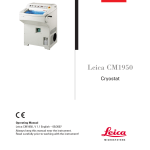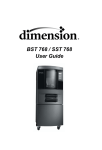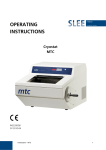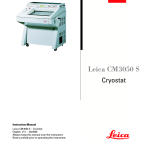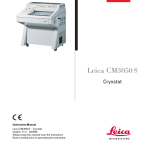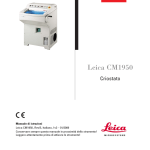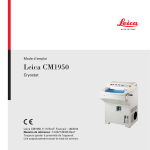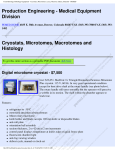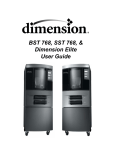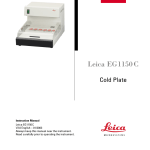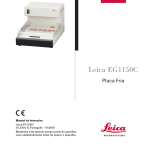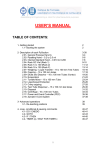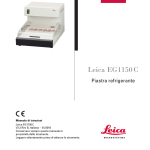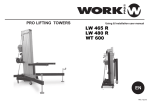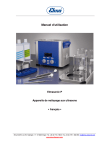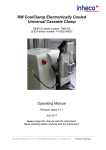Download cryostat Cm1900_en
Transcript
Leica CM1900 - Cryostat Leica CM1900 Kryostat Instruction Manual Leica CM1900 – V5.1 English - 11/2001 Always keep this manual near the instrument! Read carefully prior to operating the instrument! 1. Introduction The information, numerical data, notes and value judgments contained in this manual represent the current state of scientific knowledge and state-of-the-art technology as we understand it following thorough investigation in this field. We are under no obligation to update the present manual periodically and on an ongoing basis according to the latest technical developments, nor to provide our customers with additional copies, updates etc. of this manual. For erroneous statements, drawings, technical illustrations etc. contained in this manual we exclude liability as far as permissible according to the national legal system applicable in each individual case. In particular, no liability whatsoever is accepted for any financial loss or consequential damage caused by or related to compliance with statements or other information in this manual. Statements, drawings, illustrations and other information as regards contents or technical details of the present manual are not to be considered as warranted characteristics of our products. These are determined only by the contract provisions agreed between ourselves and our customers. Leica reserves the right to change technical specifications as well as manufacturing processes without prior notice. Only in this way is it possible to continuously improve the technology and manufacturing techniques used in our products. This document is protected under copyright laws. Any copyrights of this document are retained by Leica Microsystems Nussloch GmbH. Any reproduction of text and illustrations (or of any parts thereof) by means of print, photocopy, microfiche, web cam or other methods – including any electronic systems and media – requires express prior permission in writing by Leica Microsystems Nussloch GmbH. For the instrument serial number and year of manufacture, please refer to the name plate at the back of the instrument. Leica Microsystems Nussloch GmbH Heidelberger Str. 17 - 19 D-69226 Nussloch Tel.: Fax: eMail: Internet: © Leica Microsystems Nussloch GmbH 0 62 24 - 143 0 0 62 24 - 143 200 [email protected] http://www.histo-solutions.com Leica CM1900 – Cryostat 3 2. Table of contents 1. 2. 3. 4. 5. 6. 7. 8. 9. 10. 11. 12. 13. 14. 15. 16. 17. 18. 4 Introduction ............................................................................................................................................................................. 3 Table of contents .................................................................................................................................................................... 4 Safety instructions for handling the instrument ............................................................................................................... 5 Technical data ........................................................................................................................................................................ 8 General description ............................................................................................................................................................. 10 5.1 Designed use/improper handling ...................................................................................................................................... 10 5.2 Standard delivery ................................................................................................................................................................. 10 5.3 Optional models .................................................................................................................................................................... 10 5.4 Optional accessories ........................................................................................................................................................... 10 Unpacking the instrument .................................................................................................................................................. 11 6.1 How to open the crate ......................................................................................................................................................... 11 6.2 How to remove the packing materia ................................................................................................................................. 11 6.3 Mounting the ramp ............................................................................................................................................................... 12 6.4 Transport to the installation site ........................................................................................................................................ 13 Installation ............................................................................................................................................................................ 14 7.1 Site requirements ................................................................................................................................................................. 14 7.2 Transport to the desired site - Relocation ....................................................................................................................... 15 7.3 Assembly of the handwheel ............................................................................................................................................... 17 7.4 Locking the handwheel ....................................................................................................................................................... 17 7.5 Mounting the heat extractor .............................................................................................................................................. 17 7.6 Inserting the accessories ................................................................................................................................................... 18 7.7 Inserting the optional accessories ................................................................................................................................... 19 Operation ............................................................................................................................................................................... 20 8.1 Precooling the knife ............................................................................................................................................................. 20 8.2 Installing the knife holder base ......................................................................................................................................... 20 8.3 Inserting the knife holder .................................................................................................................................................... 21 8.4 Connection to the mains ..................................................................................................................................................... 21 8.5 Turning on the instrument .................................................................................................................................................. 21 8.6 Leica CM1900 – Overview ................................................................................................................................................... 22 8.7 Programming the desired values ...................................................................................................................................... 24 Daily operation ..................................................................................................................................................................... 30 9.1 Selection of the adecuate chamber temperature .......................................................................................................... 30 9.2 Specimen freezing ............................................................................................................................................................... 30 9.3 Activating / deactivating the specimen cooling ............................................................................................................. 31 9.4 Activating / deactivating the cryochamber cooling ...................................................................................................... 31 9.5 Inserting the specimen discs in the specimen head ..................................................................................................... 31 9.6 Inserting the knife in the knife holder ............................................................................................................................... 32 9.7 Moving the specimen towards or away from the knife via coarse feed ................................................................... 33 9.8 Trimming ................................................................................................................................................................................ 33 9.9 Adjustment of the anti-roll guide ....................................................................................................................................... 34 9.10 Sectioning .............................................................................................................................................................................. 34 Cleaning and disinfection .................................................................................................................................................. 35 10.1 Cleaning and disinfection ................................................................................................................................................... 35 10.2 Turning the instrument back on ......................................................................................................................................... 35 Removal of the microtome .................................................................................................................................................. 36 11.1 How to remove the microtome: ........................................................................................................................................ 36 Reinstallation of the microtome ........................................................................................................................................ 38 12.1 How to return the microtome to the cryochamber ........................................................................................................ 38 Maintenance ......................................................................................................................................................................... 40 13.1 General maintenance .......................................................................................................................................................... 40 13.2 Replacement of the lamp .................................................................................................................................................... 41 Troubleshooting ................................................................................................................................................................... 42 Temperature Selection Chart (in minus °C) .................................................................................................................... 45 Optional accessories .......................................................................................................................................................... 46 16.1 Orienting specimen head .................................................................................................................................................... 46 16.2 Thermal block ....................................................................................................................................................................... 47 Ordering information .............................................................................................................................................................. 48 Appendix ................................................................................................................................................................................. 49 Instruction manual V 5.1 – 11/2001 3. Safety instructions for handling the instrument Unpacking and installation Microtome knives • To ensure an adequate cooling capacity, the instrument must be set up maintaining a minimum distance from walls and furniture (see 'Technical data'). • Take care when handling microtome knives and disposable blades. The cutting edge is extremely sharp and can cause severe injury! • The instrument must be transported in an upright position or slightly tilted (max. 30°). • To ensure a safe transportation with a fork lift 3 people are required: one operating the fork lift, and the other 2 holding the instrument on either side to prevent it from sliding down. • Before connecting to the mains power, please check if the local voltage complies with the power rating specified on the name plate of the instrument (see also 'Technical data')! • Plug the instrument only to power sockets with ground! • After transporting, wait at least 4 hours before turning the instrument on. This waiting period is necesssary to allow the compressor oil , which may have been displaced during transport, to return into its original position. Failure to comply with this will cause severe damage to the instruments! • Never leave knives and knife holders with a knife/ blade mounted lying around! • Do not place a knife on a table with the cutting edge facing upward! • Never try to catch a falling knife! • Prior to manipulating the knife and specimen, or changing the specimen or knife, always lock the handwheel and cover the cutting edge with the knife guard! • Always lock the handwheel and cover the cutting edge of the knife with the knife guard during breaks! • Avoid contact with cold parts of the instrument as this can cause frostbite! Due to the weight of the instrument (170 kg) 4 people are required for transportation (2 people per handle). Leica CM1900 – Cryostat 5 3. Safety instructions for handling the instrument Cleaning and disinfection - Turning the instrument back on It is not necessary to remove the microtome for disinfecting the cryochamber, however, removal is possible, if required! • When disinfecting, please take appropriate protective measures (gloves, mask, protective clothing, etc.). • When using detergents and disinfectants please comply with the safety precautions of the disinfectant manufacturer. • Only use acetone for cleaning the plastic anti-roll plate of the knife holders CN and CS. The glass antiroll plate of the knife holder CE can be cleaned either with acetone or alcohol. • Dispose of waste liquid according to the waste disposal regulations! • Do not use uncontrolled external heaters for drying the cryochamber. This can cause damage to the cooling system! Removal/Reinstallation of the microtome • Prior to removing the microtome, turn the instrument off with the mains switch and pull the mains plug! • Remove sliding window before removing the microtome! • Before removing the microtome, lock the handwheel in the lowest position. When removing the microtome, the specimen head will rapidly fall down and might injure the operator's hands! • The microtome must be entirely dry before reinstallation. Humidity inside will condense and freeze, causing malfunctions and damage! • All components removed from the cryostat must be carefully dried before returning them to the cryochamber! • The cooling chamber must be entirely dry when turning on the instrument (Frost formation)! • When removing the microtome for cleaning or disinfection, please keep in mind the safety instructions in chapter 10 'Cleaning and Disinfection'. • Do not turn the instrument on before the cryochamber is completely dry! Frost formation! • Dry all parts completely before reinserting them in the cryochamber! • The front panel and the slit cover of the microtome must be completely dry before turning on the instrument! 6 Instruction manual V 5.1 – 11/2001 3. Safety instructions for handling the instrument Handling samples - Defrosting Maintenance • When working with possibly contaminated or infected material the general safety guidelines for laboratories must be applied! • Turn the instrument off with the mains switch and pull the mains plug, before replacing the fuses! • Before defrosting the cryochamber remove all samples! • Before defrosting the specimen head remove all samples! • Never leave samples in the cryochamber! - The instrument is not made for storing frozen specimen! • Only use fuses of the same specification ! For the required values refer to chapter 4 'Technical Data'! • Turn the instrument off with the mains switch and pull the mains plug before replacing the lamp! • If the lamp is broken, it must be replaced by the technical service, as the replacement involves a high risk of injury! • Only use lamps of the same specification! For the required type refer to chapter 4 'Technical Data'! Leica CM1900 – Cryostat 7 4. Technical data Type -1 -2 -3 -5 -6 -7 -8 -9 -10 Certificate of conformity VDE - UL/CSA - UL/CSA - VDE - - Nominal voltage Nominal frequency Power draw Max. start-up current for 5 sec Protective class Mains fuses (MDA by Bussmann) Automatic fuse Pollution degree➁ Overvoltage installation category 230 V AC 50 Hz 1800 VA 25 A eff. I T8A T10A T1 2 II 200 V AC 50 Hz 1800 VA 30 A eff. I T12A T12A T1 2 II 120 V AC 60 Hz 1800 VA 35 A eff. I T15A T1 2 II 200 V AC 60 Hz 1800 VA 30 A eff. I T15A T12A T1 2 II 208 V AC 60 Hz 1800 VA 30 A eff. I T12A T12A T1 2 II 230 V AC 60 Hz 1800 VA 25 A eff. I T12A T10A T1 2 II 240 V AC 50 Hz 1800 VA 25 A eff. I T8A T10A T1 2 II 100 V AC 60 Hz 1800 VA 30 A eff. I T8A T15A M3 2 II 100 V AC 50 Hz 1800 VA 35 A eff. I T15A M3 2 II Heat emission (max.) 1800 J/s 1800 J/s 1800 J/s 1800 J/s 1800 J/s 1800 J/s 1800 J/s 1800 J/s 1800 J/s Refrigeration CM1900 50 Hz CM1900 60 Hz 0 - -35 °C ± 3 K, at an ambient temperature of 22 °C 0 - -35 °C ± 3 K, at an ambient temperature of 22 °C Refrigeration capacity ➀ Cut-off pressure Safety factor Refrigerant* Compressor oil* 690 W 25 bar 3 275 g (± 5 g) refrigerant R 404A* 0,6 l EMKARATE RL22S, ICI* 690 W 25 bar 3 265 g (± 5 g) refrigerant R 404A* 0,6 l EMKARATE RL22S, ICI* Defrosting of cryochamber Automatic defrosting Programmable: Defrosting intervals Defrosting period: Automatic stop of manual defrosting: yes 1 defrost cycle/ 24 hours 9 minutes at -5 °C yes 1 defrost cycle/ 24 hours 9 minutes at -5 °C Manual defrosting Defrosting period: Automatic stop of manual defrosting: 9 minutes at -5 °C 9 minutes at -5 °C Quick freeze shelf Max. temperature: Number of quick freeze stations: - 43 °C (+ 0 K / - 2 K) 10 - 43 °C (+ 0 K / - 2 K) 10 -10 - -50 °C ± 2 K, at an ambient temperature of 22 °C 320 W 25 bar 3 210 g (± 5 g) refrigerant R404A* 0,4 l alpha 22, Kyodo* -10 - -50 °C ± 2 K, at an ambient temperature of 22 °C 320 W 25 bar 3 210 g (± 5 g) refrigerant R404A* 0,4 l alpha 22, Kyodo* Defrosting of specimen head Automatic defrosting no no Manual defrosting Defrosting period: Automatic stop of manual defrosting: 10 minutes 10 min. after reaching +20 °C 10 minutes 10 min. after reaching +20 °C Cryochamber Temperature range Specimen cooling Temperature range Refrigeration capacity ➀ Cut-off pressure Safety factor^ Refrigerant* Compressor oil* ➀ acc. to CECOMAF: liquid temperature 45 °C, evaporation temperature: -25°C 8 ➁ according to IEC-1010; UL 3101 Instruction manual V 5.1 – 11/2001 4. Technical data Microtome Type Section thickness setting Specimen feed Knife holder repositioning on the microtome base plate Vertical stroke Specimen retraction Maximum specimen size Microtome encapsulated in the cryochamber 0 - 60 µm, infinitely variable 25 mm 30 mm 59 mm no Ø 40 mm Cryostat Dimensions Width (w/o handwheel) Width (incl. handwheel) Depth (cabinet only) Depth (cabinet incl. mains plug) Overall height Working height 790 mm 890 mm 725 mm 800 mm 1200 mm 1000 mm Weight (instrument only) Weight incl. accessories 168 kg 170 kg Set-up conditions Distance to walls and furniture; calculated from the cabinet rear: right side: left side: 10 cm 20 cm 10 cm Plug the instrument only to power sockets with ground. Mains cable length: - 3,5 m Extendable: no The installation site must be free of draft and insolation; the floor must be free from vibrations. Lamp 50 Hz-Version: 60 Hz-Version: Working temperature range: 0 °C to -35 °C ± 3 K. Minimum ambient temperature: 18 °C Maximum ambient temperature: 40 °C Maximum relative humidity of air: 60 % Leica CM1900 – Cryostat Osram DULUX S 11 W/21 Osram DULUX S 13 W/21 *) Refrigerant and compressor oil must only be replaced by authorized service personnel! 9 5. General description 5.2 • The rapid sectioning cryostat CM1900 is provided with a fully encapsulated microtome with an independent specimen cooling system. Its graphic control panel is easy to handle due to self-explanatory symbols. The cryochamber is made of spacious stainless steel which is easy to clean. The instrument is CFC-free and is designed and manufactured according to VDE and UL regulations. Standard delivery • Cryostat with encapsulated, splash-proof microtome and independent specimen cooling. • 5 specimen discs, ø 30 mm • 1 two-parted heat extractor • 1 low-temperature stabilizer for the heat extractor • 1 cover for quick freezing shelf • 1 rimmed section waste tray • 1 storing shelf • 1 tool set • 1 instruction manual in 4 languages • 1 bottle cryocompound • 1 brush shelf • 2 brushes (broad and small) • 1 bottle cryostat oil, 50 ml • 1 rubber mat • 1 short instruction manual • 1 unpacking instruction sheet • 1 dust cover • 1 transportation crate • 1 pair of safety gloves 5.3 Optional models • The following models are available: • • CM1900 with specimen retraction CM1900 without specimen retraction Please, indicate type when ordering! 5.1 Designed use/improper handling • Samples must not be stored unattended in the cryostat for a long period since they could be destroyed in case of a power failure or malfunction of the instrument. The cryochamber temperature can rise considerably during defrosting. Heat-sensitive samples must therefore be protected from exposure to elevated temperatures and removed prior to defrosting. 5.4 Optional accessories • orienting specimen head • thermal block • storage set including waste container, consisting of: • storage shelf, left • storage shelf, right • waste container • section waste tray The instrument may only be used for the specified application and operated in accordance with the instructions given in this manual. Any other use of this instrument is considered as improper operation! 10 Instruction manual V 5.1 – 11/2001 6. Unpacking the instrument Checking if the instrument has been transported correctly Please check the TIP (N) TELL indicators immediately after arrival of the shipment. If the TIP (N) TELL Arrow Point is blue, this package has been on its side or tipped in transit. Please note on the Bill of Lading and check for damage. The same unpacking instructions are inside a transparent sheet, attached to the transport crate at arrival of the shipment. The following unpacking instructions shall help you in case of packing or transporting the instrument once again.6.1 6.1 1 1 How to open the crate 1. Loosen 3 screws (1) at the top of the two sides of the crate (7). 1 3 2 2. Loosen 4 screws of the hinges (2) at the front and rear of the crate. 2 7 Do not loosen the screws of the hinges on the lid of the crate! 4 3. Loosen 1 screw (3) at the top between the two hinges at the front and rear of the crate. 4 4 4 4 4 5 4. Loosen 3 screws (4) at the bottom on each of the four sides of the crate. 6.2 1. Remove the lid (5) and place on the ground beside the transport platform (11) with the foam parts facing down. 6 6 How to remove the packing materia 2. Remove the 4 foam parts (6). 7 3. Lift the body of the crate (7) straight up. 9 4. Take out the cardboard box (8) containing the accessories and the instruction manual at the front of the instrument. 10 8 5. Remove the dust cover (9) by pulling it upward. 6. Remove the foam part (10) at the rear. 11 Leica CM1900 – Cryostat 11 6. Unpacking the instrument 6.3 11 Mounting the ramp 1. Upon removal of the foam part (10) 2 screws (12) become visible on the base platform. 12 2. Fold down the hinges (2) at the rear and front. 3. Place the lid against the transport platform (11) from behind. The jogs (13) of the hinges (2) must point to the instrument. 2 13 4. Push the lid to the left sliding the jogs (13) of the hinges under the heads of the screws (12). 11 12 13 12 12 13 Instruction manual V 5.1 – 11/2001 6. 6.4 Unpacking the instrument Transport to the installation site The instrument must be transported in an upright position or slightly tilted (max. 30°)! 16 • The lid (5) forms a ramp for the instrument so it can be rolled off the transport platform. Do not grip the cabinet at the lid (16)! Grip the cabinet only at the marked locations ( )! 2 2 14 The wheels (14) must be guided over the hinges (2) at the front and rear. Caution: Risk of tilting! 1. Roll the instrument backwards over the ramp off the platform with caution. 5 2. Move the instrument to the installation site on its wheels. 3. The adjustable feet (15) can support the weight of the instrument when tipped at a slight angle (max. 30°). Tilt Lengthwise movement 15 14 15 Leica CM1900 – Cryostat 14 13 7. Installation 7.1 Site requirements To ensure an adequate cooling capacity, the instrument must be set up maintaining a minimum distance from walls and furniture (see 'Technical data')! The place of installation must meet the following requirements: • No direct sunlight. • Mains power socket at a distance no greater than appr. 3 m. • No drafts (air condition outlets etc.). • Even floor. • Vibration-free floor. • Obstruction-free access to the handwheel. • Room temperature always approx. 22 °C. • Air humidity must not exceed 60 %. • Distance to walls and furniture, calculated from the cabinet: - rear: 10 cm - right side: 20 cm - left side: 10 cm • No heat dissipating appliances around. High room temperatures and excessive air humidity affect the cooling capacity of the cryostat and lead to the formation of condensation water in the instrument! 14 Instruction manual V 5.1 – 11/2001 7. 7.2 Transport to the desired site - Relocation • First, check if the location meets the conditions specified in 'Site requirements'. • Transport the instrument to the desired location. • Observe the following: The instrument must be transported in an upright position or slightly tilted (max. 30°)! Installation Transport on wheels • On even floors and for short distances the instrument can be transported on wheels. Before transportation, screw the adjustable feet (1) completely down with the open-end wrench no. 16. • The instrument can be rolled lengthwise and slightly be tilted forward (see arrows). - Although the instrument cannot be rolled sideways, it can be pushed carefully in that direction. When tilting the instrument 2 people must counterbalance from the frontside to prevent the instrument from falling down and causing severe injury! Tilt Lengthwise movement 3 2 1 • When transporting the instrument on wheels (2, 3) grip the cabinet only at the marked locations ( ). • The adjustable feet (15) can support the weight of the instrument when tipped at a slight angle (max. 30°). Unscrew the adjustable feet with the open-end wrench no. 16 (when subsequently transporting the instrument any further on wheels, do not forget to screw the adjustable feet down completely). Leica CM1900 – Cryostat 15 7. Installation Transport with handles Transport with a fork lift • For lifting or carrying the instrument manually (e.g. on stairs) you can use handles (4). Screw the handles into the threads (5) of the bottom plate at both sides of the cabinet. • The handles can be ordered from your Leica Sales Unit. • The instrument can be transported with a fork lift. • The distance 'a' for insertion between the wheels is max. 540 mm. 4 4 5 Distance for insertion a = max. 540 mm 5 Due to the weight of the instrument (170 kg) 4 people are required for transportation (2 persons per handle). To ensure a safe transportation with a fork lift 3 people are required: one operating the fork lift, and the other 2 holding the instrument on either side to prevent it from sliding down. • Unscrew the adjustable feet at the installation site (1) with the open-end wrench no. 16 (see Fig. page 16). This is absolutely necessary for a stable stand. 16 Instruction manual V 5.1 – 11/2001 7. 7.3 Installation Assembly of the handwheel 1 2 3 4 • Insert the pin (1) of the handwheel shaft into the hole (2) of the handwheel. • Mount the spring washer (3) on the screw (4). • Tighten the screw (4) with an Allen key no. 6. To dismount, proceed in reverse order. 7.4 • To unlock, push the locking pin (5) to the left from the recess at the handwheel. 7.5 Mounting the heat extractor Locking the handwheel 7 6 5 • For locking the handwheel rotate the handle until it is in the upper position. Push the locking pin (5) into the recess at the handwheel. The locking position is marked by a black dot (6). If necessary, move the handwheel slightly forth and back until the locking mechanism engages. Leica CM1900 – Cryostat • Fix the holding device of the heat extractor by tightening the 2 screws (7) with the Allen key no. 4 to the threaded holes on the left sidewall of the cryochamber and insert the heat extractor. 17 7. Installation 7.6 Inserting the accessories • Insert the storing shelf (1). 1 18 • Insert the rimmed section waste tray (2). 2 Instruction manual V 5.1 – 11/2001 7. 7.7 Installation Inserting the optional accessories • Insert the waste container (3). • Insert the right storage shelf (4). 4 3 • Insert the left storage shelf (5). • Insert the section waste tray (6). 5 6 Leica CM1900 – Cryostat 19 8. Operation 8.1 Precooling the knife • To precool the knife put the open knife rest including the knife on the storage shelf inside the cryochamber. 8.2 Installing the knife holder base • To unlock relocate the lever to the front (1). 1 • Slide the guide (2) of the knife holder base (3) onto the T-piece (4) of the microtome base plate as shown. The knives are extremely sharp! Handle with care! Never try to catch a falling knife! 3 2 4 • To clamp relocate the lever (1) backwards. 1 • If the lever cannot be relocated entirely for clamping, lift it up and shift it to the next position. 20 Instruction manual V 5.1 – 11/2001 8. 8.3 Inserting the knife holder • To insert the knife holder, unlock the lever (1) turning it upward, slightly to the rear. • Insert the knife holder (2) onto the knife holder base (3) as shown. Operation • Do not connect other consumers to this electric circuit. • Connect the mains plug to the mains power outlet at the wall. After transporting, wait at least 4 hours before turning the instrument on. This waiting period is necessary to allow the compressor oil, which may have been displaced during transport, to return to its original position. Failure to comply with this can cause severe damage to the instrument! 1 2 8.5 Turning on the instrument • Bring the switch of the automatic fuse (2) to the upper position. • Turn on the mains switch (1). • Close the sliding window. 3 1 • To clamp, turn the lever (1) forward. 8.4 2 Connection to the mains During the start-up of the compressor the nominal voltage must not drop below the values specified in the 'Technical Data'. Please note that the compressor requires a start-up current between 30 and 40 A. Therefore, the electric circuit at the installation site must be inspected by an electrical engineer to ensure that it meets the requirements for a troublefree operation of the instrument. Failure to comply with the above will cause severe damage to the instrument! To avoid frost formation always put the cover on the quick freeze shelf. Always cover the quick freeze shelf during breaks and overnight. • Check mains voltage and mains frequency to comply with the specification on the type plate. Plug the instrument only to power sockets with ground! Leica CM1900 – Cryostat 21 8. Operation 8.6 Leica CM1900 – Overview Display of Actual Temperature and Set Temperature of the specimen head display flashes during specimen head defrost - display alternately reads "LL'' / Actual Temperature while "Max Cool" is activated - flasing decimal points indicate that specimen head refrigeration is disconnected. Max-Cool-button to directly select the maximum (lowest) temperature of the specimen head +/- buttons to select cryochamber temperature +/- buttons to select real time Display of Real Time, Defrost Time and Error Messages. When display reads defrost time, the two LEDs flash. The LEDs are extinguished when the control panel is locked via the Key button. ON/OFF button of illumination +/- buttons to select defrost time +/- buttons to select specimen head temperature 22 Display of Actual Temperature and Set Temperature of the cryochamber display flashes during chamber defrost - flasing decimal points indicate that chamber refrigeration is disconnected. Key button to lock/ unlock display settings and to turn on/off chamber or specimen cooling "Melting Snowflake" button to activate defrosting Instruction manual V 5.1 – 11/2001 8. Operation Luminous indication (LED) - flashes while coarse feed is in motion and and lights up when the specimen head has reached its rear limit position Coarse Feed buttons, (Arrow buttons) on the left of the cryochamber. To move the specimen head rapidly towards the knife (lower button) or away from the knife (upper button). Luminous indication (LED) - lights up when the specimen head has reached its front limit position Mounting the knife holder onto the knife holder base Quick freezing shelf, with heat extractor and lowtemperature stabilizer Leica CM1900 – Cryostat 23 8. Operation 8.7 Programming the desired values Turning the lamp on and off • Turn the lamp on or off. Setting the time • Set the time. • The actual time is set with the +/- buttons in the control panel marked with the clock symbol. When pushing the + or - button for more than 1 s, the time value increases or decreases continuously (Autorepeat-function). Programming the temperature of the cryochamber • Select the desired temperature of the cryochamber. • The temperature of the cryochamber is set and indicated on the control panel marked with the cryostat symbol. The actual temperature is the standard indication. For indication of the desired value, touch the + or button. Set the desired value via the + / - buttons. When pushing the + or - button for more than 1 s, the chamber temperature value increases or decreases continuously. The actual value will be indicated 5 seconds after finishing the programming. 24 Instruction manual V 5.1 – 11/2001 8. Operation Programming the specimen temperature • Select the desired temperature of the specimen. • The specimen temperature is set and indicated on the control panel marked with the specimen head symbol. The actual temperature is the standard indication. For indication of the desired value, touch the + or button. Set the desired value via the + / - buttons. When pushing the + or - button for more than 1 s, the specimen temperature value increases or decreases continuously. The actual value will be indicated 5 seconds after finishing the programming. Specimen temperature - 'Max-Cool' function • The snowflake button for the 'Max-Cool'-function is in the panel with the specimen head symbol. Push the button for programming the lowest temperature possible of the specimen head (-50 °C). • Push the snowflake button again for stopping the 'Max-Cool'-function. The temperature adjusts to the value programmed prior to activating the 'Max-Cool'-function. • Alternate flashing of 'LL' and actual temperature indicates activation of the 'Max-Cool'-function. Leica CM1900 – Cryostat 25 8. Operation Programming the defrost cycle • Set the beginning of the automatic defrost cycle. The automatic defrost cycle is activated once in 24 hours. It is set with the + /- buttons on the right of the panel with the clock symbol. The buttons are marked by a melting snowflake. • Touch the + or -button for indication of the beginning of the defrost cycle which has actually been set. At the same time, the LEDs between the indication of hours and minutes are flashing. • To change the beginning of the defrost cycle in steps of 15 minutes push the + or -button. When pushing the + or - button for more than 1 s, the defrost time value increases or decreases continuously. Before starting the defrost cycle remove all samples from the cryochamber! • When activating the automatic defrost cycle the specimen head temperature adjusts to a temperature between -10°C and -5°C (reduced ice formation). The specimen head cooling turns off. This is confirmed by the flashing of the decimal points on the panel for the specimen cooling. The specimen cooling turns automatically back on after 4 hours, once the chamber temperature varies by less than 5 K from the set temperature. • If you want to turn the specimen cooling back on manually before the automatic activation sets in, push the + or - button on the panel for the specimen cooling and then the key button. • The temperature of the specimen cooling first raises to +10°C and then adjusts to the programmed specimen temperature. 26 Instruction manual V 5.1 – 11/2001 8. Operation Before defrosting the cryochamber remove all samples! Manual defrosting of the cryochamber • Push the manual defrost button (with the melting snowflake) on the left over the key button to activate the defrost cycle of the cryochamber on demand. • Activation is confirmed by an audible signal. • Then, push + or - button on the panel for the cryochamber temperature. • The manual defrost cycle (9 min.) is activated. • There is a flashing indication of the temperature of the cryochamber during the whole defrost cycle. • If necessary, push the manual defrost button on the panel for the cryochamber temperature. • When activating the manual defrost cycle the specimen head temperature adjusts to a temperature between -10°C and -5°C (reduced ice formation). The specimen head cooling turns off. This is confirmed by the flashing of the decimal points on the panel for the specimen cooling. • Ten seconds after the manual defrost cycle has been completed, the specimen cooling turns back on. Leica CM1900 – Cryostat 27 8. Operation Before defrosting the specimen head remove all samples! Manual defrosting of the specimen cooling • Push the manual defrost button (with the melting snowflake) on the left over the key button to activate the defrost cycle of the specimen head. • Activation is confirmed by an audible signal. • Then, push + or - button on the panel for the specimen temperature. • There is a flashing indication of the specimen temperature during the whole defrost cycle. • For 10 minutes the specimen head is adjusted to a temperature of 20°C and 30°C. • Subsequently, the instrument adjusts to the specimen temperature which has been programmed prior to the manual defrost cycle. • If necessary, push the manual defrost button again to deactivate the manual defrost cycle. Display lock • Push the key button for 5 seconds to protect the programmed values against unintended alterations. The programmed values cannot be modified after having pushed the key button. • Push the key button once more for 5 seconds to unlock the display. • When the display is locked, the LEDs between the hour and minute indication on the time panel are turned off. • Key button is also used for turning on/off the chamber and specimen cooling: For this purpose, push the + or - button of the corresponding panel and subsequently press the key button. 28 Instruction manual V 5.1 – 11/2001 8. Operation Error messages - The display indicates the following malfunctions. Error code E 001: Temperature limit error or breaking of the temperature sensor of the specimen cooling system. Error code E 011: Temperature limit error or breaking of the temperature sensor of the cryochamber cooling system. - If the instrument is being exposed to temperatures of more than +35 °C over a long period, e. g. during transportation a temperature limit error may be indicated. This error message disappears as soon as the instrument has reached a temperature lower than 35 °C. If the error message does not disappear, call the technical service. Never leave samples in the cryochamber! The instrument is not made for storing frozen specimen! Unfixed samples used in cryostats must always be considered as possibly contaminated! Ensure that the appropriate disinfection methods are applied (see 'Cleaning and Disinfection')! Leica CM1900 – Cryostat 29 9. Daily operation 9.1 Selection of the adecuate chamber temperature • For choosing the adecuate chamber temperature, see the temperature chart on page 50. 9.2 Specimen freezing • After freezing the specimen insert the heat extractor back in the fixing device and place it in its original position on the low-temperature stabilizer (2). • The low-temperature stabilizer cools down the heat extractor to the lowest temperature possible, thus ensuring maximum performance when freezing specimen. • Freeze the specimen on the quick freeze shelf onto the specimen disc. • Place the heat extractor onto the specimen to speed up the freezing process. 2 • Rotate the heat extractor to place it on the three freezing stations within reach. To place the heat extractor onto one of the other freezing stations, lift the ring (1), remove the heat extractor from the fixing device and put it on the desired station. 1 30 Instruction manual V 5.1 – 11/2001 9. Daily operation 9.3 Activating / deactivating the specimen cooling • The specimen cooling is activated by subsequently pushing the + or - button in the control panel for specimen cooling and the key button. • Deactivation of the specimen cooling is done in the same way. To activate / deactivate the specimen or cryochamber cooling you must push the relevant buttons subsecuently. Do not push simultaneously! 9.4 Activating / deactivating the cryochamber cooling 9.5 Inserting the specimen discs in the specimen head Prior to manipulating the knife and specimen, or changing the specimen or knife, always lock the handwheel and cover the cutting edge with the knife guard! • First, lock the handwheel. Bring the handle to the upper position. The locking pin must meet the black mark on the cabinet. • Push the locking pin into the recess at the handwheel. • To control if the locking mechanism has engaged try to move the handwheel slightly back and forth. • The chamber cooling is activated by subsequently pushing the + or - button in the control panel for • Deactivation of the chamber cooling is done in the same way. • Insert the specimen disc in the specimen head. • Loosen the screw (1) on the specimen head turning it counterclockwise, insert the specimen disc and retighten the screw. 1 Leica CM1900 – Cryostat 31 9. Daily operation 9.6 Inserting the knife in the knife holder • Insert and clamp the precooled knife/blade in the knife holder. For further details please refer to the separate instruction manual for your knife holder. Take care when handling microtome knives and disposable blades. The cutting edge is extremely sharp an can cause severe injury! Never leave knives and knife holders with a knife/blade mounted lying around! Do not place a knife on a table with the cutting edge facing upward! Never try to catch a falling knife! Prior to manipulating the knife and specimen, or changing the specimen or knife, always lock the handwheel and cover the cutting edge with the knife guard! Always lock the handwheel and cover the cutting edge of the knife with the knife guard during breaks! Avoid contact with cold parts of the instrument as this can cause frostbite! 32 Instruction manual V 5.1 – 11/2001 9. Daily operation 9.7 Moving the specimen towards or away from the knife via coarse feed • Push the coarse feed buttons, situated on the left upper side of the cabinet, to move the specimen towards or away from the knife. The upper coarse feed button automatically retracts the specimen from the knife, the lower button moves the specimen toward the knife. 9.8 Trimming • When the specimen has been moved towards the knife it can be trimmed to the required sectioning plane. The section thickness can be adjusted by turning the knob on the right beside the specimen cylinder. • Start sectioning after having finished trimming or having reached the appropriate section thickness. • Only touch the upper coarse feed button slightly to retract the specimen from the knife. The specimen cylinder automatically moves to the rear limit. The return movement can be stopped by pressing one of the coarse feed buttons. • The forward movement only operates as long as the button is pressed. (This is a safety feature to protect both specimen and knife from damage!) Always observe the specimen during the forward movement, thus avoiding that specimen and knife collide by mistake! A collision can cause severe damage both to the knife and to the specimen and the specimen disc! Leica CM1900 – Cryostat 33 9. Daily operation 9.9 Adjustment of the anti-roll guide • Adjust the anti-roll guide to the knife holder before sectioning. • On both sides of the anti-roll plate the profiles of the individual knife types are engraved. C stands for knife, profile c; D for knife, profile d; and E for disposable blades.* • The corresponding letter on the upper side of the anti-roll plate pointing towards the user must not be inverted.* • Adjust the anti-roll guide correctly. For further details of adjusting the anti-roll guide please refer to the instruction manual for knife holders. Attention: Only use acetone for cleaning the plastic anti-roll plate of the knife holders CN and CS. The glass anti-roll plate of the knife holder CE can be cleaned either with acetone or alcohol. *) Applies only for knife holders CN and CS. 9.10 Sectioning • When sectioning, make sure that the section smoothly slides down between the anti-roll plate and the knife or the pressure plate of the knife holder. • There are two different methods of taking sections: • 1. Applying the section onto a warm slide: Fold back the anti-roll plate and carefully approach a slide of room temperature to the section. The section 'flies' onto the slide and adheres tightly to the slide's surface. Unfortunately, it is not possible to orientate the section subsequently on the slide. • 2. Applying the section onto a precooled slide: Place the section with a smooth brush on a slide which has been cooled down to the temperature of the cryochamber. Unfortunately, the section does not lay smoothly on the slide and must be smoothed with a brush. When using a precooled slide, always warm it with your hand from the bottom side after the specimen has been placed smoothly on it, thus making sure that the section adheres tightly to it and does not slide down when going on with preparation (e. g. staining). Take care when sectioning. The cutting edge of the knife is not covered! 34 Instruction manual V 5.1 – 11/2001 10. Cleaning and disinfection 10.1 Cleaning and disinfection The microtome is encapsulated splash-proof in the cryochamber. Thus, spray disinfection with Leica Cryofect is possible. • Turn off the instrument and wait until the cryochamber has room temperature. • The microtome is encapsulated splash-proof in the cryochamber. Thus, it is not necessary to remove it for disinfection. • Spray disinfection is possible. When disinfecting, please take appropriate protective measures (gloves, mask, protective clothing, etc.). When using detergents and disinfectants please comply with the safety precautions of the disinfectant manufacturer. Only use acetone for cleaning the plastic antiroll plate of the knife holders CN and CS. The glass anti-roll plate of the knife holder CE can be cleaned either with acetone or alcohol. • Before disinfecting, put an appropriate vessel underneath the marked hose connection on the righthand side of the cabinet (see below). • Drain the cleaning liquid through the hose after the prescribed reaction time by pulling the stopper. • Dispose of the waste liquid according to the waste disposal regulations. Do not use uncontrolled external heaters for drying the cryochamber. This can cause damage to the cooling system! 10.2 Turning the instrument back on Do not turn the instrument on before the cryochamber is completely dry! Frost formation! The front panel and the slit cover of the microtome must be completely dry before turning on the instrument! Dry all parts completely before reinserting them in the cryochamber! • The stopper must be plugged to the hose again! Leica CM1900 – Cryostat 35 11. Removal of the microtome 11.1 How to remove the microtome: 2. Loosen the specimen head turning the Allen key no. 5. counterclockwise. It is not necessary to remove the microtome for disinfecting the cryochamber. Prior to removing the microtome, turn the instrument off with the mains switch and pull the mains plug! Remove the sliding window before removing the microtome! Before removing the microtome, lock the handwheel in the lowest position. When removing the microtome, the specimen head will rapidly fall down and might injure the operator's hands! 1. Remove the section waste tray . 36 3. Pull out the specimen head carefully and place it on the storage shelf which is on the left of the microtome. Instruction manual V 5.1 – 11/2001 11. 4. Hold the front panel of the microtome as shown (seizing the border with your left hand and the opening with your right hand) and take it out. Removal of the microtome 6. Loosen the central screw with the Allen key no. 5. 5. Take out the semicircular slit cover. 7. Pull the microtome forward until the cable becomes reachable. Disconnect the cable and pull the microtome out of the guidance and remove it from the cryochamber. Keep in mind that the microtome is heavy! Leica CM1900 – Cryostat 37 12. Reinstallation of the microtome 12.1 How to return the microtome to the cryochamber 2. While pressing the microtome against the left guidance tighten the central screw with the Allen key no. 5. The microtome must be entirely dry before reinstallation. Humidity inside will condense and freeze, causing malfunctions and damage! Dry all parts completely before reinserting them in the cryochamber! The cooling chamber must be entirely dry when turning on the instrument (Frost formation)! When removing the microtome for cleaning or disinfection, please keep in mind the safety instructions in chapter 10 'Cleaning and Disinfection'. 1. Insert the microtome in the cryochamber. Connect the cable before pushing the microtome completely back. 38 3. Mount the semicircular slit cover from behind on the front panel of the microtome. Instruction manual V 5.1 – 11/2001 12. Reinstallation of the microtome 4. Mount both parts together on the specimen cylinder of the microtome. 6. Tighten the specimen head with the Allen key no. 5 by turning it clockwise. 5. Mount the specimen head on the specimen cylinder. 7. Insert the section waste tray. Leica CM1900 – Cryostat 39 13. Maintenance 13.1 General maintenance The microtome is virtually maintenance-free. To ensure a smooth operation of the instrument over several years we recommend the following: 5 • Have the instrument inspected by a qualified service engineer authorized by us once a year. • Enter into a service contract at the end of the warranty period. For further information, please contact your local Leica service center. 1 • Clean the instrument daily. 4 3 2 • From time to time: lubricate the seat of the heat extractor (1), the clamping piece (T piece) (2) and the clamping lever (3) on the microtome base plate as well as the specimen cylinder (4) slightly with cryostat oil. Press the coarse feed button (5) to move the specimen cylinder forward, apply some drops of oil on the cylinder and move it back to the final home position. • Clean the ventilation slits of the liquefiers on both sides of the instrument with a brush, broom or vacuum cleaner to free from dust and dirt in the direction of the fins. • Do not carry out any repairs on your own as this will invalidate the warranty. Repairs may only be carried out by qualified service engineers authorized by Leica. 40 Instruction manual V 5.1 – 11/2001 13. 13.2 Replacement of the lamp Maintenance Turn the instrument off with the mains switch and pull the mains plug before replacing the lamp! • Slightly lift the sliding window (1) holding it by the grip (2) and pull it out to the front. 1 If the lamp is broken, it must be replaced by the technical service, as the replacement involves a high risk of injury! 2 Removal of the lamp • The lamp is mounted behind a glare shield and therefore not visible. • Touch the lamp for better orientation. • Lightly tilt the flourescent tube down to the left and pull it out of the clip (3). • Hold the lamp with both hands and pull it to the left out of the holder (4). Only use lamps of the same specification! Installation of the new lamp 3 4 Type: (230 V / 50 Hz) OSRAM DULUX S - 11 W (120 V / 60 Hz) OSRAM DULUX S - 13 W • Hold the lamp in the correct mounting position as shown and push it to the right until it engages in the holder. • Replace the sliding window. • Reconnect the instrument to the mains power and turn it on. Leica CM1900 – Cryostat 41 14. Troubleshooting Problem Causes Remedies Frost on chamber walls and microtome Cryostat is exposed to air currents (open windows and doors, air conditioning). Frost built-up by breathing into the cryochamber. Change place of installation for the cryostat. Sections smear Specimen not cold enough. Anti-roll plate not yet cold enough, thus warming the section. Select lower temperature. Wait until knife and/or anti-roll plate have reached chamber temperature. Sections splinter Specimen too cold. Select higher temperature. Sections not properly flattened Static electricity/air currents. Specimen not cold enough. Large area specimen. Remove cause. Select lower temperature. Trim the specimen parallel, increase section thickness Reposition anti-roll plate. Anti-roll plate poorly positioned. Wear mouth protection. Anti-roll plate poorly aligned with knife edge. Incorrect clearance angle. Blunt knife. Align correctly. Dirt on knife and/or anti-roll plate. Clean with dry cloth or brush. Top edge of anti-roll plate damaged. Replace anti-roll plate. Blunt knife. Use different part of the knife or replace the knife. Sections curl on anti-roll plate Anti-roll plate does not protrude far enough beyond the knife edge. Readjust correctly. Scraping noise during sectoning and specimen return movement Anti-roll plate protrudes too far beyond the knife edge and is scraping against the specimen. Readjust correctly. Ridged sections Knife damaged. Use different part of the knife or replace the knife. Replace anti-roll plate. Sections not properly flattened despite correct temperature and correctly aligned anti-roll plate Edge of anti-roll plate damaged. Chatter during sectioning Specimen insufficiently frozen onto the specimen disc. Specimen disc not clamped tightly. Knife not clamped tightly enough. Specimen has been sectioned too thickly and has detached from disc. Very hard, inhomogeneous specimen. Refreeze specimen onto the disc. Blunt knife. Use different part of the knife or replace knife. Use knife with differnt profile. Knife profile inappropriate for specimen cut. Incorrect clearance angle. Condensation on anti-roll plate and knife during cleaning 42 Set correct angle. Use different part of the knife or replace the knife. Brush, forceps and/or cloth too warm. Check disc clamping. Check knife clamping. Refreeze specimen onto the disc. Increase section thickness; reduce specimen surface area if necessary. Set correct angle. Store all tools on storage shelf in the cryochamber. Instruction manual V 5.1 – 11/2001 14. Troubleshooting Problem Causes Remedies Anti-roll plate damaged after adjustment Anti-roll plate too high above the knife edge. The adjustment was carried out in the direction of the knife. Replace anti-roll plate. Be more careful next time! Thick-thin sections Temperature incorrect for the tissue cut. Knife profile inappropriate for the specimen cut. Ice buildup in the knife back. Handwheel speed not uniform. Knife not clamped tightly enough. Specimen disc not clamped tightly enough. Cryocompound applied to cold specimen disc; specimen detached from disc after freezing. Blunt knife. Select correct temperature. Inappropriate section thickness. Incorrect clearance angle. Microtome not properly dry before reinstallation. Dried specimen. Use knife with different profile (c or d). Remove ice. Adapt speed. Check knife clamping. Check disc clamping. Apply cryocompound to warm disc, mount specimen and freeze. Use different part od the knife edge or replace knife. Select correct section thickness. Set correct angle. Dry microtome thoroughly. Prepare new specimen. Anti-roll plate is too warm or incorrectly positioned. Fat on the corner or edge of anti-roll plate. Anti-roll plate not correctly fixed. Rust on the knife. Cool down anti-roll plate, or reposition correctly. Remove fat from anti-roll plate. Flattened sections curl up when antiroll late is picked up Anti-roll plate too warm. Cool down anti-roll plate. Sections tear Temperature too low for the tissue cut. Blunt part, dirt, dust, frost or rust on the knife. Top edge of the anti-roll plate damaged. Hard particles in the tissue. Dirt on knife back. Increase temperature and wait. Remove cause. Microtome was not entirely dry when switching refrigeration, which produced ice built up in the micrometer feed system. Microtome defective. Remove microtome and dry thoroughly. Tissue sticks or crumbles on the antiroll plate Inconsistent or insufficient specimen feed Leica CM1900 – Cryostat Fix correctly. Remove rust. Replace anti-roll plate. --Clean. Call technical service. 43 14. Troubleshooting Problem Causes Remedies Cryostat inoperational Mains plug not properly connected. Defective fuses, or automatic fuse has triggered. Check if properly connected. Replace fuses, or switch automatic fuse back on. If not possible, call technical service. Specimen disc cannot be removed Moisture on the underside cause the specimen to freeze to the freezing shelf or specimen head. Apply concentrated alcohol to the contact point. No or insufficient refrigeration of the cryochamber Stopper not placed in drain hole. Cooling system or electronic drive defective. Replace the stopper. Call technical service. Sliding window collects condensation Air humidity and room temperature too high. Comply with the requirements for the installation site. No or insufficient refrigeration of the specimen cooling system Cooling system or electronic drive defective. Call technical service. Lamp does not work Lamp defective. Check lamp and replace it, if necessary. Call technical service. Switch defective. 44 Instruction manual V 5.1 – 11/2001 15. Tissue 10 - 15 Adrenals ❉ Bone marrow ❉ Brain Bladder Temperature Selection Chart (in minus °C) 15 - 25 ❉ ❉ ❉ Breast- fatty Breast - little fat Cartilage ❉ Cervix ❉ ❉ ❉ Fat Heart and vessel Intestine Kidney Laryngeal ❉ Lip Liver Lung Lymphoid Musclular Nose Pancreas Prostate Ovary Rectal ❉ ❉ ❉ ❉ ❉ ❉ ❉ ❉ ❉ ❉ ❉ ❉ ❉ ❉ Skin with fat Skin without fat Spleen or bloody tissue Testicular ❉ ❉ Thyroid Tongue Uterus curettings - ❉ 25 - 50 ❉ ❉ ❉ ❉ ❉ ❉ ❉ ❉ The temperature values given above are based on long-term experience, however, these are only ap proximate values, as any tissue may require particular adjustments. Leica CM1900 – Cryostat 45 16. Optional accessories 16.1 Orienting specimen head 1 Mounting the orienting specimen head: 1. Loosen the specimen head (1) turning the Allen key no. 5 counterclockwise. 2 2. Pull out the specimen head (1) carefully and place it on the base. 3. Loosen 4 screws on the insulating ring (2) with an Allen key no. 3. Remove insulating ring and adapter (3). 3 2 4. Mount insulating ring (2) on the short adapter (3a) of the specimen orientation and fix both parts with the 4 short screws to the corresponding threaded bores on the cylinder. 3a 5. Mount the specimen head (1) on the insulating ring (2) and fix it with the Allen key no. 5. 6 7 8 4 5 6. Insert the specimen orientation (4) in the specimen head (1) and fix the clamping screw (5). 7. Insert the specimen disc (6) and fix the clamping screw (7). 8. The specimen can be oriented when the clamping lever (8) is loose. Tighten lever (8) after orienting the specimen. 1 46 Instruction manual V 5.1 – 11/2001 16. Optional accessories 16.2 Thermal block • The thermal block (1) facilitates the removal of the frozen specimen from the specimen disc. • Place the cap (2) on the required side, so that the appropriate location hole for the specimen disc is visible. • Insert the shaft of the specimen disc in the appropriate location hole (3) at the top or bottom of the thermal block. • After about 20 seconds, the frozen specimen can be removed from the specimen disc with forceps. • If the cap is too loose, readjust it with the small screw (4). Do not overtighten the screw! • Once the specimen is removed, take the thermal block out of the cold cryochamber. 3 1 2 4 Keep the thermal block outside the cryochamber at room temperature. Place it in the cryochamber only for specimen removal. Leica CM1900 – Cryostat 47 17. Ordering information Ordering information Knife holder Knife holder CN as above, but without knife holder base Knife holder CE for low profile blades with glass anti-roll guide Knife holder CE for high profile blades with glass anti-roll guide Pressure plate for high profile blades for Cat. no. 0419 30383 Pressure plate for low profile blades for Cat. no. 0419 30390 Knife holder base for knife holders CN, CE and CS Knife holder CS without knife holder base Auxiliary clamping device for knife holder CS Replacement knife guard Knife support bar Magnetic blade holder for Cryolap disposable blades 0419 18649 0419 30383 0419 30390 0502 29553 0502 29551 0419 26140 0419 19787 0419 20971 0419 19455 0419 25681 0419 25171 Specimen discs Specimen disc, 20 mm ø Specimen disc, 25 mm ø Specimen disc, 30 mm ø Specimen disc, 40 mm ø Specimen disc, 55 mm ø Specimen disc, 50 x 90 mm 0370 08636 0416 19275 0370 08587 0370 08673 0419 26491 0419 26750 other sizes on request Accessories OCT cryocompound, bottle of 125 ml Thermal block Leica Cryofect disinfectant spray Glass anti-roll guide for knife holder CE Replacement plate for anti-roll guide, 50 mm, for knife holders CN,CS Replacement plate for anti-roll guide, 55 mm, for knife holders CN,CS Replacement plate for anti-roll guide, 70 mm, for knife holders CN,CS Anti-roll guide, complete assembly, for knife holders CN,CS Cryostat oil, No. 407, 50 ml Adapter for Miles TissueTek® specimen discs Orienting specimen head Storage set including waste container (complete) consisting of: - storage shelf, left - storage shelf, right - waste container - section waste tray 48 0201 08926 0398 18542 0387 30795 0358 13583 0419 19506 0419 26489 0419 26937 0419 26938 0336 06098 0436 26747 0452 28800 0452 28763 0452 27904 0452 27905 0452 27906 0452 27907 Instruction manual V 5.1 – 11/2001 18. Appendix Product changes Disposal • Due to a policy of continuous improvement of our products, Leica Instruments reserves the right to change specifications without notice. • The instrument or parts of the instrument must be disposed of in compliance with local laws. Technical service information Warranty Leica Microsystems Nussloch GmbH guarantees that the contractual product delivered has been subjected to a comprehensive quality control procedure based on the Leica in-house testing standards, and that the product is faultless and complies with all technical specifications and/or characteristics warranted. The warranty conditions depend on the contents of the individual contract concluded, supplemented by the warranty conditions of your local Leica sales unit. The warranty period starts on the day of passing of risk or on the day of delivering the product. Excluded are warranties for defects or damage attributable to, for example, operational and normal wear and tear, improper use, faulty operation, installation and/or use of non-original spare parts, installation and/ or use of non-original accessories, negligent handling of the product by the customer, connection to unsuitable power supply sources, operation at incorrect voltage, force majeure such as fire, lightning, earthquakes, humidity etc. We will not assume any liability for damages due to improper handling of the product. Any repairs and/or exchange of parts of the product must be carried out by technical service engineers authorized by Leica. Otherwise warranty claims can no longer be made. The local Leica sales unit, the Leica representative responsible or the factory in Nussloch must be consulted prior to any changes to the instrument, to any modifications as well as prior to any use of the instrument in combination with non-Leica components not expressly authorized by Leica. Spare parts and accessories not supplied by Leica can under no circumstances be considered as inspected and/ or approved by Leica. Installation or use of any such parts may impair the technical design features and thus the properties of the instrument. Warranty claims can only be made as long as the product or system has been operated according to its designated use and according to the instructions given in this manual. In case of justified claims the manufacturer is entitled to repair or replace the goods. Rescission of the sales contract can only be demanded after two unsuccessful attempts at repairing the instrument on the part of the manufacturer. Leica CM1900 – Cryostat • If you require technical service or replacement parts under warranty, please contact your Leica Sales Representative or Dealer from whom the instrument was purchased. • Be sure to state the model type, serial number and date of delivery. Leica Instruments GmbH (Germany) cannot accept goods returned without official authorization. • If an instrument or any part of it is to be returned to Leica, please note the following: a. If the instrument or any part of it has been exposed to or been in contact with potentially pathogenic or radioactive materials, it is essential to decontaminate the instrument or part. Decontamination must be explicitly be confirmed by the customer. Our service engineers have to enquire about this. b. Ensure that there is no radioactivity or hazardous bacteria present and advise Leica of any decontamination procedure that may have been carried out. • Should the instrument or any part of it be received in a condition that Leica considers to be a potential biological hazard, the instrument or part will be returned unrepaired at the expense of the customer. • When requesting a service call, please provide the following information: a. Model type and serial number of the instrument; b. Location of the instrument and the person to contact; c. The reason for the service call. 49 Notice 50 Instruction manual V 5.1 – 11/2001


















































